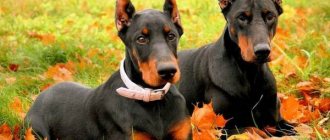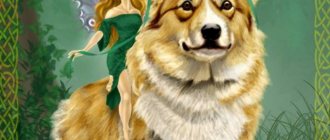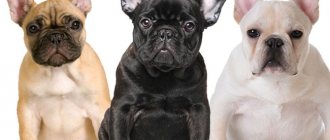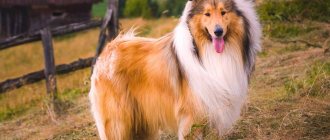History of the Boxer breed
Female and male German Boxer
The ancestors of the German Boxer are bulldogs, mastiffs and bullenbeissers. It was as a result of the mixing of their blood that this breed was born, which began to conquer the world in 1896.
Boxers from the late 19th century and modern boxers are not exactly the same thing. In those early years, they were used as shepherds, for transporting goods and hunting wild boars and bison. Often early representatives of the breed became participants in dog fights and even bullfights. During the First World War, the German army successfully used them as postmen and scouts. At the same time, German boxers also showed themselves as guide dogs. Later, dogs of this breed also revealed their “creative” talents, successfully performing in circus and theatrical performances.
An interesting version is the earlier origin of boxers. Some researchers claim that their direct ancestors are the Tibetan Great Danes, who ended up in Rome and Greece back in ancient times. It is believed that ancient boxers were larger and more aggressive. Their inherent bloodthirstiness helped them cope well with military tasks. They were used for protection and as a baiting dog during the hunt for large forest game, as well as in the popular entertainment of those times - dog fights, which in terms of the intensity of passions were practically not inferior to gladiatorial ones.
Since the end of the century before last, the German boxer began to conquer the world, he had many fans in different parts of the world, who even opened clubs dedicated to this incredibly stately, dignified and beautiful dog. Her appearance seems aggressive (sometimes it may seem that she is ready to rush at a stranger and tear him apart), but behind her lies a good nature and an easy-going character. This is a great merit of the breeders, who did everything possible to add such traits as kindness and balance to agility, endurance and speed of reaction.
When a dog wants to play, it begins to move its paws in the air, as if boxing. This special manner, which makes it unlike other dogs, predetermined the name of the breed. According to the owners' reviews, boxers have all the necessary qualities for living in a family, so they are the best!
History of the breed
The name of the breed is surprising: Boxer. It is not known exactly why the German dog was named after a traditional English sport, but there are a couple of versions.
- the dog's muzzle in profile is very similar to a boxing glove;
- the full face of the dog resembles the face of a boxer after a lost fight;
- German boxers actively use their front paws in games or fights - as if they were boxing.
Tired
The ancestors of the German boxer include a bullenbeiser (translated as a bulldog). These formidable great-great-ancestors gave the best part of their qualities to the boxer. It is believed (one version) that Bullenbeissers come from Assyrian fighting dogs.
In Europe, these powerful dogs were used for hunting. Their task was to catch already wounded game and hold it until the owner appeared. The jaws of these hunters at hand were quite consistent with their work, that is, the animals had a large mouth with a wide set of teeth and an iron grip.
There is a version that mastiffs and bulldogs took part in the creation of the breed. No matter how the breed develops, it is known for sure that in Munich in 1895, the creators of the German boxer appeared at a dog exhibition with a single specimen of the breed. He impressed dog lovers so much that they created a boxing club in Munich.
This lucky year is considered the year of birth of the German boxer breed.
Features of the German boxer
Boxer puppy
A German boxer at the age of 18 months is already an adult dog, fully developed physically. However, by the age of one and a half years the inner world still remains “childish”. For this reason, attempts to train a dog during a period of his emotional immaturity are practically futile, that is, he does not respond to commands, and the owner even begins to think that he is communicating with a deaf person. But at one fine moment a breakthrough comes in training, and your pet suddenly begins to understand everything that they previously tried to teach him, but in vain.
The Boxer is a sociable dog, it gets along easily with other four-legged inhabitants of the house, but sometimes the cockiness in its character takes over and it begins to chase the yard cats. It happens that a dog of this breed easily gets into fights with other dogs, and fights are often provoked by him himself. By nature, a boxer is a real fighter; he is dexterous, brave and strong. If you train him correctly, you can raise an excellent guard. The childlike spontaneity inherent in a boxer remains with him throughout his life. The dog shows enviable stubbornness, but never achieves his goal with aggression. His main weapon is humor and charm, which no loving owner can resist.
Representatives of this breed have amazing sensitivity, they are very smart and cunning. Sometimes they can be noisy, which is perceived by some owners as a drawback, therefore, in order to develop the best character traits and minimize shortcomings, boxers must be trained. With the right approach to this task, you can achieve amazing results, as boxers perceive training as a game and easily succumb to it.
Running boxer
German boxer character
The German boxer has a balanced character, self-confident, fearless and calm. The dog's character is a very important parameter and requires special attention. For a long time, the boxer has been famous for its loyalty and devotion to its owner and his family, as well as for its vigilance and fearlessness as a protector. is suspicious of strangers and very affectionate with all family members. Friendly and playful in play, but fearless in attack. Easy to train. The Boxer is an excellent companion and family member and serves as a companion and protector in the home.
Appearance and special features of the breed
Boxers have a stocky build. They are also called "square" dogs because their height and length are approximately the same. A wide and deep chest, coupled with a strong back with a slight slope in the pelvic area, is quite consistent with this body type. At the same time, representatives of this breed do not look squat - rather the opposite. The dogs look stately, they have a proud posture, and all thanks to their dry muscles and lean belly. Their limbs are massive, correctly placed, without curvature, so they do not spoil the “figure”. The Boxer's neck is of medium length, strong and muscular, and the tail is long and straight.
Two boxers playing
A distinctive feature of the breed is a slightly protruding lower jaw, a slightly upturned nose and high-set ears - thin, hanging slightly forward. When circumcised (cupping), they acquire a pointed shape, which gives them the correct position. A Boxer's eyes are dark, intelligent, and they can tell a lot about the breed. You can read curiosity in his gaze; it glows with energy, but not with aggression.
The skin of boxers, with the exception of the forehead and cheeks, fits tightly and does not form any folds. The coat is short, hard and also lies tightly. Only two colors are considered classic for German boxers: red and brindle. The first can range from rich red to light yellow shades. The brindle has its own “extremes”: from golden to gloomy dark. The breed standard stipulates that the stripes should appear as clear lines.
Whatever the color, a kind of dark mask is an invariable attribute on the dog’s face. The presence of white markings is acceptable, giving the breed an aesthetic appearance. White, black, gray dogs with a large number of stripes and spots are considered “rejected”. And one more thing: if you plan to send your pet to an exhibition, then docking of the ears and tail will have to be sacrificed. Experts categorically do not recommend performing such manipulations with a boxer.
general description
- The height of the German boxer is average, approximately 60 cm at the withers. An adult dog weighs from 25 to 32 kg.
- Dogs of this breed have superbly developed and voluminous muscles. Their movements are active, energetic, filled with nobility and strength.
- Boxers, despite their “square” physique, have sufficient substance. That is, they cannot be called clumsy, heavy or, on the contrary, too light.
- They are characterized by balance and often serve as guides for blind people.
- Males are larger than females. Pedigree parents can give birth to up to 7 puppies per litter.
Head
The head matches the proportions of the body and, giving the dog a special identity, does not look too massive or too light.
The muzzle, ideally, is as wide and powerful as possible. The correct ratio of the skull and muzzle provides the boxer with a harmonious head. No matter where you look from - front, side or top - the muzzle relative to the skull remains in the right proportion and does not look too small. The Boxer's head is dry, there are no folds or wrinkles on it. The latter are formed, and this is allowed, only in cases where something has alerted the dog. There are natural wrinkles on the muzzle on both sides. But not everywhere, but only in the area from the base of the bridge of the nose down. A black mask is clearly visible against the general background of the muzzle. Despite the gloomy shade, it does not at all impart gloominess to the dog’s appearance.
The upper region of the skull is not wide, not flat and extremely angular. Its shape is somewhat convex, but not shortened or spherical. The prominence of the tubercle in the occipital region is not excessive. The furrow on the forehead (primarily the area between the eyes) does not differ in depth and is only slightly visible. The area from the forehead to the bridge of the nose has a ledge that is clearly visible. The bridge of the nose is not drooped and, unlike bulldogs, it is not turned up.
Boxer muzzle
Teeth
The lower jaw, if compared with the upper, is slightly longer. Its distinctive feature is its upward curvature. The base of the upper jaw is wide, tapering towards the end. Boxer teeth are in excellent health and very strong. The canines are impressively large and widely spaced. The incisors are located on the same line, very evenly. The form of a dog's bite is undershot.
Eyes
Boxers' eyes are rather large, dark in color, not deep-set and not prominent. The edges of the eyelids are also dark. Dogs look intelligently and at the same time energetically, their gaze is kind and does not carry any threat.
Ears
German boxer
They are located on the sides in the upper region of the skull, their fit is high, and their size is proportionate. In a state when nothing bothers the dog, and there is no need to listen to sounds, they are adjacent to the cheekbones. If your pet is alert, the ears will immediately turn forward, forming a clear bend.
Nose and lips
Thanks to the nose, the dog's muzzle has a complete look, its tip is slightly higher than the base. The lobe is slightly upturned, it is wide, the color is black, the nostrils are also wide.
The upper lip is pronounced and fleshy. It covers the free area formed due to the fact that the lower jaw is longer. The upper lip is supported by the lower canines.
Neck
The Boxer's neck is lean, muscular and at the same time round and long (but not excessively). From the mound on the back of the head towards the withers, the upper border of the neck forms a graceful arch.
Frame
The boxer's withers are clearly defined; the body is supported by strong, developed limbs. The back is wide, with a “pumped up” muscular system, but short and level. The croup is slightly rounded, wide, slightly sloping. The pelvis, especially for females, is wide and long.
The chest area is so deep that it reaches all the way to the elbows and is equal to half the height of the dog at the withers. Its front part is powerful and superbly developed.
The underline has an elegant curve towards the ischial tuberosity. The groin cannot boast of length, it is moderately toned.
Tail
Boxer with undocked ears and tail
Has a fairly high seating position. Usually it is not stopped, that is, it is left unchanged - the way it is by nature.
Limbs
If you stand in front of the dog, you can see that the front legs are parallel to each other. The bones of the limbs are strong.
The blades are firmly connected to the body, differ in length and are inclined. The shoulders are also long, located at the correct angle relative to the shoulder blades. The elbows are not pressed too tightly to the chest.
The forearms are also not short at all, they are located vertically and are muscular. The pasterns, on the contrary, are short, almost vertical. The wrists are clearly defined: they are strong, but not too massive.
The front paws have a rounded shape, they are small in size, compact, the pads are hard and elastic. The hind legs are naturally well-pumped, straight, the hips are distinctly wide and long.
Boxing team
The hind legs are slightly longer than the front legs. They are also compact, the pads are hard and elastic.
When the boxer is calm, his knee joints move forward so clearly that they even reach a conventional perpendicular, outlined in the direction of the surface from the iliac tuberosities.
Muscularity is also inherent in the legs. The hock joints, although not massive, are strong and well defined.
Wool
The hair fits tightly to the skin, it is short and hard, and shiny.
Color
Boxers come in red or brindle color. Any shade of the first is allowed, from light yellow to red-brown. The most typical for the breed, or, in other words, preferred, are reddish-red tones.
The brindle color has the appearance of dark or black stripes on a red background. They should be clearly defined and contrast with the background. White areas are not forbidden and, accordingly, are not considered a “defect” of the breed - on the contrary, they can even decorate the dog.
Red boxer
Brindle boxer
Possible defects
Variations that do not meet the breed standards listed above are considered faulty. These deficiencies should be assessed according to their severity and the extent to which they affect the dog's daily lifestyle and health.
Disqualifying faults
The white boxer is considered rare and can cost more than dogs that meet the breed standard.
Physical: congenital bobtail. Behavioral: cowardice or, conversely, aggressiveness.
Defects of the testes: in healthy male dogs, they should be normally developed, completely descended into the scrotum.
Any representative of the breed showing obvious physical defects or behavioral abnormalities shall be disqualified.
Lifespan
A German boxer lives on average 11-12 years. There are happy exceptions to this rule.
Content
- The main character traits of a German boxer: female or male?
- Character of a German boxer
- Basic commands
- Raising a dog
In this article you will learn what features of character and behavior are inherent in the German boxer. After studying this information about the temperament and disposition of a German boxer at different ages, you will get an idea about the breed. Find out how the character of a bitch differs from the behavior of a dog. We hope our article will help you figure out which gender of puppy is best for you.
Photo of an adult boxer
Boxer character
Cheerful, playful, curious, cheerful, energetic - these traits fully characterize German boxers.
These dogs are also loyal, becoming very attached to their owner and his family members. Positive traits stay with a boxer all his life; he likes it when there are a lot of people and noise around him. A boxer who has gone through a good training school gets along well with small family members, treats them with care, never offends them, and plays with them with pleasure. He will not only become an excellent companion for your child, but also a reliable guard.
Boxer with a child
A representative of this breed, subject to good upbringing and social adaptation, will get along well not only with other dogs living in the house, but even with cats. However, the real “temptation” for them is small animals and birds. Your pet can be taught not to touch them, and he will not do this in front of you. But, as they say, it’s better not to leave the boxer alone with them.
The boxer loves to fool around and warmly greets all the people he knows. He never loses his vigilance and therefore will be a good protector for his household. This brave, athletic breed sometimes retains its excellent guarding and guarding qualities until a very old age. In order for the dog not to show his not the best qualities - excessive noise, stubbornness, and sometimes uncontrollability - he needs an owner who will dominate him.
Adults have a calm temperament, which is a direct result of proper training at an early age. The popularity of the breed is precisely due to this very poise, coupled with natural intelligence and tolerance towards people and other pets. The boxer shows the most tender feelings towards his owner and shows with all his appearance that he really likes being around. If you do not cultivate communicative qualities in him, the dog will show suspicion of strangers all his life, bark at them, and refuse to let them near his owner.
The boxer retains his childlike activity and spontaneity until the age of 2-3 years, although physically he matures by the age of one and a half years. Many owners who are not aware of the intricacies of the breed complain that the Boxer does not understand the commands that are taught to him. In fact, it takes time for a dog to learn and retain new information. The owners are then convinced that this is so: at one fine moment the dog begins to do everything that it seemed to have been taught to no avail for a long time.
Character and temperament
Bloodhound (hound dog): description of the breed
The formidable and warlike appearance of the animal is at odds with its pleasant and gentle disposition. The dog's nervous system is strong and balanced. She loves attention and care, which she responds with affection and love for her owner and other household members.
The Boxer is a very intelligent, quick-witted and cunning breed, easy to train, and will happily learn and follow commands. Animals have very active and expressive facial expressions. From its appearance it immediately becomes clear that the dog is sad or in a great mood.
Boxers have expressive facial expressions
Attitude towards children and others
A Boxer breed dog treats all family members equally with love. She adores children, can play with them for hours, and will never harm them, even if a small child grabs their tail or ears. He is very wary of strangers, but makes contact quite quickly and easily if he does not feel a threat to himself or his owner.
Attitude towards loneliness
Boxer dogs have an increased requirement for company and communication. It is not recommended to leave them alone for a long time, because they will become very sad.
It is strictly forbidden to keep a dog chained in the yard. Boxers cannot stand being alone for a long time, without the company of household members. Because of this, they often fall into a depressed state.
One of the advantages of the breed is the ability to keep it in an apartment
Additional Information! A Boxer, even if left alone at home for a long time, will never spoil things.
Security and guard qualities
The boxer is an excellent guard and defender. He will never show aggression unless the current situation requires it. A dog can rush at a person only if it feels that he is a threat to his owner or his property.
Training and education
Boxers are smart, well-trained dogs. At the same time, they are stubborn and perceive new information selectively. They refuse to carry out many commands, preferring to obey only those that they like.
High five!
Some owners believe that training a representative of this breed needs to be done using the “carrot and stick” method, that is, punishing for disobedience and rewarding for precise execution of commands. However, the “whip” in this technique will be superfluous, since boxers react poorly to punishment. Various incentives (praise, treats, awards) make them more receptive to training. By using a specific set of commands, you are sure to achieve excellent results during the training process. With the correct and clear formulation of tasks, the boxer remembers the learned commands for a long time.
Boxer training usually begins from the moment the puppy is in the house, and full training begins from three months. First of all, the dog is taught basic commands, such as “Sit!”, “Lie down!”, “Near!”. When your pet has mastered them, you can begin teaching the “Come to me!” command. This command is considered the main one; the boxer must perform it in any situation and the first time.
The Boxer loves the outdoors very much, so the countryside suits him perfectly. But even in an apartment, your four-legged friend will feel good if you regularly take him for walks in a large park, where he can take long walks. The dog will be an excellent companion for an owner who loves morning or evening jogging. He is ready to spend the whole day outdoors.
Dogs of this breed are often left to frolic in the courtyards of houses, first making sure that the fence is strong. The latter is not out of place: there are many cases where German boxers jumped over the fence and ran away. Their jaws are so powerful that, if left alone at home, they can even bite through the lock on the door.
Education and training
From a certain age, boxers respond well to training. However, you should not expect them to carry out all commands. Dogs are quite stubborn and therefore perform only the actions they like. So we need to find an approach.
You need to start raising and training a Boxer when the puppy arrives in the house. Full training should begin when the baby is three months old. Commands “Sit!”, “Lie down!”, “Near!” are considered the first ones that the pet must learn. Next, they accustom him to the order “Come to me!” A properly trained boxer must do it the first time, in any situation.
Some puppyish stubbornness of the animal leads the owner to think about applying punishments for disobedience. But the “stick” method often leads to negative results. All sorts of rewards in the form of treats and praise help to quickly and correctly perceive commands.
A specially selected set of training exercises will have an effect, thanks to which the owner will achieve success in raising his four-legged friend. It is interesting that the boxer remembers the learned tasks for a long time and performs them without delay.
Education should begin gradually:
- firstly, you need to accustom the puppy to the toilet, basic hygiene standards;
- secondly, respond to your nickname;
- thirdly, teach him to walk on a leash.
The pet tries to test its strong teeth on different pieces of furniture or even locks. Only persistence along with the owner’s boundless patience will help wean him from a bad habit, otherwise it will not be easy to achieve a positive result.
The love of walking in the fresh air does not limit keeping a German to a country house. In apartments, a four-legged pet will be no less comfortable if it is given regular, long walks. He especially likes to go jogging with his owner in the morning or evening.
Care and maintenance
Wherever you place your pet, in an apartment or a country house, it will fit in perfectly everywhere. He will be comfortable even in an ordinary kennel, but on the condition that another dog shares this “living space” with him.
In general, German Boxers are quite easy to care for, but they do not tolerate cold and high humidity well.
Since Boxers have short hair, it, unlike long-haired breeds, does not get tangled or tangled, and therefore does not need frequent combing.
Frequent bathing is not recommended for Boxers. If your pet gets dirty during active play, simply wipe the dirty area with a damp cloth.
Since a boxer is very active by nature, a sedentary lifestyle is contraindicated for him, he must receive maximum physical activity. For the healthy development of a dog of this breed, a balanced diet is also required.
The dog's eyes require special attention. Tear secretions or dust often accumulate in their corners, and a soft handkerchief is enough to remove them. If your dog's eyes are red, a soothing ointment will help. However, do not self-medicate: the drug must be prescribed by a veterinarian.
Dirt may accumulate in the ears. To remove wax and dust from the ear, just wipe it with a handkerchief wrapped around your finger or wipe it with a damp swab. Cleaning a Boxer's ears with a cotton swab or putting alcohol in them is strictly prohibited.
A boxer's claws should not touch the floor when walking. Otherwise, they need to be cut off. For this purpose, special forceps are used. The procedure should be carried out no more than twice a month, otherwise you will cause discomfort and pain to your pet.
Boxer in the apartment
Rules for keeping and caring for a boxer
You can only keep a Boxer in an apartment or house. Keeping in an enclosure or on a chain in outdoor conditions is unacceptable.
These animals do not tolerate heat well, so when walking in hot weather there is a risk of heat stroke, which will lead to the inevitable death of the animal.
In cold weather, your pet should be walked in warm overalls, as these dogs have short, close-fitting hair and no thick undercoat. You need to walk your dog at least twice a day. Animals love outdoor games, so the owner needs to stock up on an arsenal of toys, balls, frisbees and other devices.
In terms of care, they are absolutely picky. Once a week it is necessary to clean your ears and teeth. Do not forget about regular examination of the eyes and mucous membranes for inflammation.
Frequent bathing is undesirable, only in case of severe contamination during walks.
The pet's fur practically does not shed, so once a week it is combed with a special rubber mitten with fine bristles.
The diet should consist of fresh meat, boiled or fresh vegetables, porridge, and dairy products. It is forbidden to feed the animal smoked, flour products, as well as sweets. Animals often suffer from allergies to various components.
Boxers cannot tolerate extreme heat or cold. Therefore, when walking you need to look at the condition of your pet.
It is allowed to feed your pet with ready-made dry food, but its quality must correspond to super-premium class food, not lower. Mixing the two types of feeding is not permissible.
Boxer health and illness
Two boxers on a leash
Despite the fact that boxers are given 11-12 years of life by nature, on average they rarely live to be 10 years old. The reason lies in a weak immune system. Because these dogs are uncomfortable in cold temperatures, they are prone to hypothermia, colds and allergies. To ensure that their health is not endangered, the premises in which German boxers are kept must be dry and draft-free. In wet and windy weather, it is better to refrain from walking.
The most common diseases of this breed include the following: heat intolerance, allergies, deafness, benign and malignant tumors, stomach torsion, hypothyroidism (decreased thyroid function), arthritis, heart problems, dysplasia (hip and elbow), degenerative myelopathy ( As a result of this disease, paralysis of the lower limbs is possible).
Animal character
Despite their menacing appearance, boxers are very friendly and affectionate animals. Boxers become very attached to their owner and family members. These dogs get along well with small children and will never offend them.
Boxers also quickly get along with other pets. However, outside the house you should not let them near other people's animals.
Boxers treat strangers with caution and distrust. Representatives of this breed are reserved and calm, but when danger arises for the owner, they show all their fighting qualities in all their glory.
Boxers take a long time to “grow up”, so until they reach the age of three they behave like puppies. With insufficient exercise, Boxers can exhibit unwanted behavior, such as damaging furniture, barking for no reason, and aggression.
This dog is not suitable for homebodies, sedentary and overly busy people.
How to choose a puppy
In addition to meeting the breed standard, an important criterion for choosing a future pet should be whether its character matches yours. You must also initially decide for what purpose you are choosing a German boxer. If your goal is not for your dog to participate in various exhibitions and you just want to engage in breeding, a sociable companion dog will be just right. The puppy should show his playfulness, friendliness and desire to communicate with you.
Mom and boxer puppy
The Boxer is perfect for active, cheerful people, because it is a sporty dog. Even if you choose a “not elite” puppy, communicating with him and training him will bring a lot of pleasure. Running for many kilometers is not a problem for him; he will keep you good company on hikes and excursions to hard-to-reach places.
Many people would like to become boxer breeders in order to sell puppies in the future. For this purpose, do not skimp on a good bitch, which will become the starting point for breeding. She must meet the following criteria: be a descendant of a famous family with excellent titles. In order not to make a mistake in choosing, it is better to purchase a breeding puppy from well-known nurseries, which guarantee that you are not buying a “fake”. You should also pay attention to the qualities of the puppy’s parents: they must have excellent characteristics inherent in this breed and be mentally balanced.
You should definitely inquire about the health of your future pet, whether he has been tested for spondylosis deformans, hip dysplasia, behavioral abnormalities and eye diseases. Any of these ailments poses a real danger to Boxers and can even cause the death of the dog. It would be a good idea to request from the breeder a document that records the results of the litter examination in order to find out how many puppies the commission rejected. If the number of such defects turns out to be high, it is better not to adopt a puppy, as there is a risk of transmitting defects to offspring.
How much does it cost and how to choose a puppy?
German Boxer puppies are inexpensive. From breeders, a pet-class puppy can cost from 10,000 rubles, possibly cheaper; puppies from parents of champions and laureates will cost 50-70% more. Brindle-colored puppies are often more expensive than solid red ones; if the puppy has small white spots, the price for the baby may be reduced.
Just don’t forget, if you take a baby from a breeder, ask for a puppy card (metric), check whether the puppy has a brand, the vaccinations given to the puppy must be listed in the veterinary passport.
Good to know! You don’t have to pay anything for measurements, vaccinations, branding. All this comes with the puppy.
When choosing a puppy you need to pay attention to the following:
- The puppy must be well-fed and strong.
- If the tail is docked (although this is now prohibited by the standard), check for an unhealed wound.
- Carefully examine the baby's face - the eyes should be clean and clear; the ears are also clean, without discharge; the nose is wet and cold.
- The coat is smooth and shiny; make sure there are no rashes (they are clearly visible on the abdomen);
- If the puppy is healthy, he is playful, active, and cheerful.
- If a boxer puppy hides and won’t be picked up, the puppy is most likely a coward. This cannot be treated, it is a disqualifying sign of the breed.
Photos of boxer puppies
How much does a boxer cost?
Boxers are relatively inexpensive and can be purchased in almost any region of our country.
You won’t have to look long for puppies of the “show” and “breeding” classes. You should treat your future purchase responsibly and thoroughly study the breed standard so that you don’t end up being deceived when making your own choice. Those who lack experience and knowledge are advised to seek advice from specialists. The cost of a German boxer is influenced by factors such as conformation, age and origin. You can purchase a puppy from private breeders for 3,000 rubles. Only he will be without a pedigree: from the documents it will be possible to obtain only a veterinary passport.
Puppies from purebred parents, which have, in addition to a veterinary passport, a brand and a puppy card, are more expensive - from 8,000 rubles. Be sure to pay attention to the contents of these documents. The veterinary passport must contain notes on vaccinations and parasite prevention. Do not forget that all necessary vaccinations for a puppy are given between the ages of 2 and 3 months.
A puppy card is like a metric for a child; based on it, you will receive a pedigree for your pet in the future. Each such card contains the following data: date of birth, information about parents, which breeder it was purchased from, coat color, brand number and nickname. The mark is placed on the ear or groin area at the time of sale. A puppy card is a very serious document. Without a certificate of inspection of the puppies by the breeding commission, which includes authorized dog handlers, it cannot be issued.
Inexperienced owners are advised to be in close contact with the breeders and consult with them. Specialists who care about their job will never refuse advice and will try to help in solving possible problems with the puppy at the stage of their occurrence. This will help the boxer develop properly, learn to get along with his owners and explore the world. And how your pet will grow up depends only on you.











